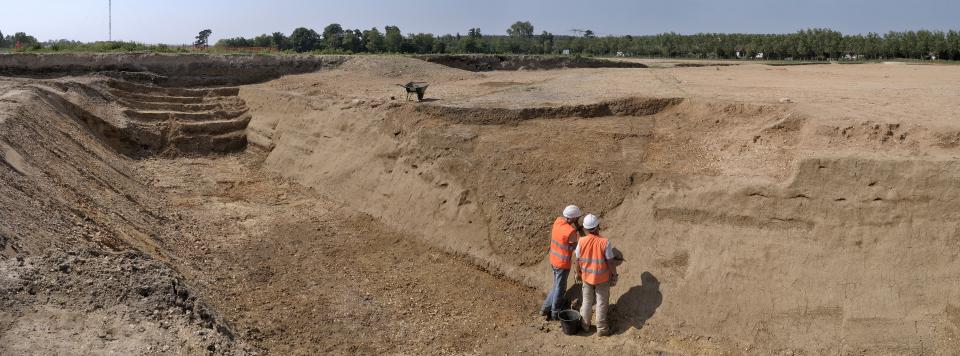You are here
Rediscovery of the Fort Saint-Sébastien, a training camp for the troops of Louis XIV in the Seine Valley
On the Archères plain (Yvelines), a team of Inrap archaeologists is excavating the Fort Saint-Sébastien, the camp at which the troops of Louis XIV were trained for the siege of Maastricht.
These excavations, curated by the State (Drac Ile-de-France) and realized by Inrap for the siaap (Syndicat Interdépartemental pour l’Assainissement de l’Agglomération Parisienne), are a preliminary phase in the modernization of the installations of the syndicate. The 28 hectares excavated cover the entire southern line of attack of the fort.
Louis XIV and Fort Saint-Sébastien: the art of war

Constructed in 1669, the Fort Saint-Sébastien is a 600 m by 380 m quadrilateral. It is an earthwork fortification with trenches, taluses and palisades, allowing simulations of stronghold sieges to be realized. The impressive trenches of the fort are 7 m wide and 3 m deep. They are equipped with angled bastions and redans on the sides of the entrances. The entire length of the internal talus (escarpe) is covered with remarkable mudbrick masonry whose main function was to absorb the shock of cannonballs. The training areas include complex networks of approach trenches, which are part of a system of attack developed by Vauban and used on a large scale during the siege of Maastricht in 1673.
The Fort Saint-Sebastien is currently the only one of its kind known. It is an exceptional example of a poliorketikos, the art of the siege, from the second half of the 17th century, which until now had never been addressed by archaeology in France.
This period is also important in the history of war. It marks a transition in French military history with the beginning of a career military; for the first time, soldiers were recruited rather than enlisted, equipped with uniforms, paid and trained.
From Achères… to the storming of Maastricht
Over a two year period, as many as 30,000 soldiers were stationed at the Fort Saint-Sébastien. The archaeologists have uncovered the camps and quarters of the troops, represented inside the fort by aligned buildings, cellars, wells and hearths. The abundant objects contained in the structures (pottery, faunal remains, glass, playing dice, clay pipes, etc.) reveal the lifestyle and diet of the soldiers, as well as the provisioning methods of the Royal Army.
All of these discoveries shed light on the daily lives of the soldiers and the social and spatial organization of a very hierarchical military community where foot soldiers, police, mounted soldiers and musketeers all lived together.
In conjunction with abundant textual and iconographic archives, the archaeological data have already led to the identification of two occupation phases represented by different spatial organizations, and this despite the short existence of the fort. In August 1670, the well trained troops of Louis XIV broke camp and left on their mission. In 1671, the Fort Saint-Sébastien was leveled and the land re-cultivated.
The soldiers that had been stationed at Archères were those who, alongside Charles de Batz-Castelmore, the Count of Artagnan, fought during the Holland war (1672-1678) and became famous in 1673 for taking control of Maastricht in record time. It normally would have taken several months to realize such a military operation.
The production society Gédéon Programmes is production a 52 minute documentary, directed by Lauren Marmol, on the excavations of the Fort Saint-Sébastien. This film is co-produced by the Histoire channel, Inrap and Dassault Systèmes, with support from the Drac Ile-de-France, the cnc, the Procirep-Angoa and the media program of the European Commission. It will be aired in 2013 on the Histoire channel.
Mahaut Tyrrell
Media communication
Inrap, Media relations and partnerships
01 40 08 80 24
mahaut.tyrrell [at] inrap.fr
Laure Ferry
Cultural development and communication
Inrap, direction interrégionale Centre - Île-de-France
01 41 83 75 51
laure.ferry [at] inrap.fr

